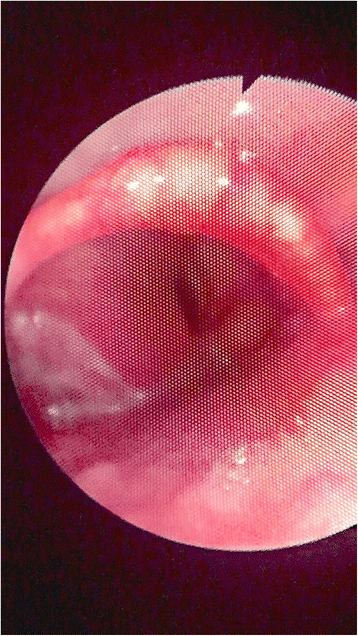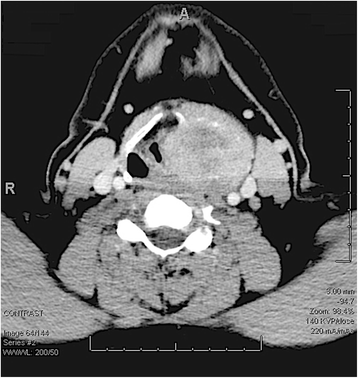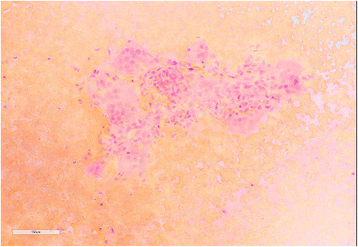A large giant cell tumor of the larynx: case report and review of the literature
- PMID: 28376853
- PMCID: PMC5379533
- DOI: 10.1186/s40463-017-0198-y
A large giant cell tumor of the larynx: case report and review of the literature
Abstract
Background: Giant cell tumors (GCTs) are typically found in the metaphyseal-epiphyseal area of long bones but can also occur in the head and neck region. GCT of the larynx is a rare entity with only 42 reported cases in the international literature. Furthermore, to the best of our knowledge this is the largest laryngeal GCT reported in the literature to date. GCT of the larynx can present with dysphonia, dyspnea, and/or dysphagia and should be considered in the differential diagnosis of a neck mass.
Case presentation: This case report describes a giant cell tumor of the left thyroid cartilage in a 30-year-old man who initially presented with dysphonia and dysphagia. Computed tomography (CT) revealed a 5 × 5.7 cm mass centered on the left thyroid cartilage, which was further diagnosed by histopathology as giant cell tumour by open biopsy. The patient was counselled on treatment options and it was decided to proceed with a surgical approach. The patient consented to and successfully underwent a total laryngectomy (TL). Currently the patient has no evidence of disease at 13 months follow-up, has an optimal prosthetic voice, and is able to tolerate all textures of foods.
Conclusion: GCTs of the larynx have a good prognosis and can be treated successfully through complete resection of the tumor, negating the need for adjunctive therapy such as radiation, chemo or denosumab therapy.
Keywords: Case report; Giant cell tumor; Larynx; Thyroid cartilage.
Figures






References
-
- Federova SS. Giant cell tumor of the larynx. Vestn Otorinolaringol. 1951;4:80–1. - PubMed
-
- Wagemann W. Riesenzellgeschwulst in Kehlkopfraum. HNO. 1952;3:92–3.
-
- Perrino A. Tumore a cellule gigantic della laringe. Ann Laringol (Torino) 1958;57:140–9.
-
- Kaliteevskii PF, Korol’kova IA. Nabliudenie lokalizatsii osteoblastoklastomy v gortani [A case of localization of osteoblastoclastoma in the larynx] Vestn Otorinolaringol. 1966;28:69–71. - PubMed
Publication types
MeSH terms
LinkOut - more resources
Full Text Sources
Other Literature Sources

